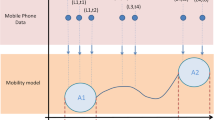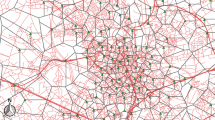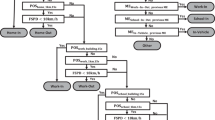Abstract
The main objective of this work was the development of a new modelling tool for quantification of human exposure to traffic-related air pollution within distinct microenvironments by using a novel approach for trajectory analysis of the individuals. For this purpose, mobile phones with Global Positioning System technology have been used to collect daily trajectories of the individuals with higher temporal resolution and a trajectory data mining, and geo-spatial analysis algorithm was developed and implemented within a Geographical Information System to obtain time–activity patterns. These data were combined with air pollutant concentrations estimated for several microenvironments. In addition to outdoor, pollutant concentrations in distinct indoor microenvironments are characterised using a probabilistic approach. An example of the application for PM2.5 is presented and discussed. The results obtained for daily average individual exposure correspond to a mean value of 10.6 and 6.0–16.4 μg m−3 in terms of 5th–95th percentiles. Analysis of the results shows that the use of point air quality measurements for exposure assessment will not explain the intra- and inter-variability of individuals’ exposure levels. The methodology developed and implemented in this work provides time-sequence of the exposure events thus making possible association of the exposure with the individual activities and delivers main statistics on individual’s air pollution exposure with high spatio-temporal resolution.









Similar content being viewed by others
References
Allen D (2011) Getting to Know ArcGIS ModelBuilder. ESRI PR. 362 pp
Ashbrook D, Thad S (2003) Using GPS to learn significant locations and predict movement across multiple users. Pers Ubiquit Comput 7:275–286
Baklanov A, Hänninen O, Slordal LH, Kukkonen J, Bjergene N, Fay B, Finardi S, Hoe SC, Jantunen M, Karppinen A, Rasmussen A, Skouloudis A, Sokhi RS, Sorensen JH, Odegaard V (2007) Integrated systems for forecasting urban meteorology, air pollution and population exposure. Atmos Chem Phys 7:855–874
Ballesta PP, Field RA, Fernandez-Patier R, Galan-Madruga D, Connolly R, Caracena AB, De Saegera E (2008) An approach for the evaluation of exposure patterns of urban populations to air pollution. Atmos Environ 42:5350–5364
Beckx C, Int Panis L, Arentze T, Janssens D, Torfs R, Broekx S, Wets G (2009) A dynamic activity-based population modelling approach to evaluate exposure to air pollution: methods and application to a Dutch urban area. Environ Impact Assess Rev 29:179–185
Bock HH (1996) Probabilistic models in cluster analysis. Comput Stat Data Anal 23:5–28
Brauer M, Hoek G, Van Vliet P, Meliefste K, Fisher P, Wijga A, Koopman LP, Neijens HJ, Gerritsen J, Kerkhof M, Heinrich J, Bellander T, Brunekreef B (2002) Air pollution from traffic and the development of respiratory infections and asthmatic and allergic symptoms in children. Am J Respir Crit Care Med 166:1092–1098
Brunekreef B, Holgate ST (2002) Air pollution and health. Lancet 360:1233–1242
Burke JM, Zufall MJ, Ozkaynak H (2001) A population exposure model for particulate matter: case study results for PM2.5 in Philadelphia, PA. J Expo Anal Environ Epidemiol 11:470–489
Dons E, Int Panis L, Van Poppel M, Theunis J, Willems H, Torfs R, Wets G (2011) Impact of time–activity patterns on personal exposure to black carbon. Atmos Environ 45:3594–3602
Freijer JI, Bloemen HJT, Loos S, Marra M, Rombout PJA, Steentjes GM, vanVeen MP (1998) Modelling exposure of the Dutch population to air pollution. J Hazard Mater 61:107–114
Gauderman WJ, Vora H, McConnell R, Berhane K, Gilliland F, Thomas D, Lurmann F, Avol E, Künzli N, Jerrett M, Peters J (2007) Effect of exposure to traffic on lung development from 10 to 18 years of age: a cohort study. Lancet 369:571–577
Georgopoulos PG, Wang SW, Vyas VM, Sun Q, Burke J, Vedantham R, McCurdy T, Ozkaynak H (2005) A source-to-dose assessment of population exposures to fine PM and ozone in Philadelphia, PA, during a summer 1999 episode. J Expo Anal Environ Epidemiol 15:439–457
Gerharz L, Pebesma E (2012) Using geostatistical simulation to disaggregate air quality model results for individual exposure estimation on GPS tracks. Stoch Environ Res Risk Assess 27:223–234
Gerharz LE, Krüger A, Klemm O (2009) Applying indoor and outdoor modeling techniques to estimate individual exposure to PM2.5 from personal GPS profiles and diaries: a pilot study. Sci Total Environ 407:5184–5193
Gerharz LE, Klemm O, Broich AV, Pebesma E (2013) Spatio-temporal modelling of individual exposure to air pollution and its uncertainty. Atmos Environ 64:56–65
Graff A (2002) The new German regulatory model—a Lagrangian particle dispersion model. In: 8th International Conference on Harmonisation within Atmospheric Dispersion Modelling for Regulatory Purposes
Gulliver J, Briggs DJ (2005) Time-space modeling of journey-time exposure to traffic-related air pollution using GIS. Environ Res 97:10–25
Health Effects Institute (2010) Traffic-related air pollution: a critical review of the literature on emissions, exposure, and health effects, HEI Special Report 17. Health Effects Institute, Boston
Hertel O, Jensen S, Hvidberg M, Ketzel M, Berkowicz R, Palmgren F, Wåhlin P, Glasius M, Loft S, and Vinzents P et al (2008) Assessing the Impacts of Traffic Air Pollution on Human Exposure and Health. In: Fischer M et al (eds) Road pricing, the economy and the environment, pp. 277–299
Hoek G, Beelen R, de Hoogh K, Vienneau D, Gulliver J, Fischer P, Briggs D (2008) A review of land-use regression models to assess spatial variation of outdoor air pollution. Atmos Environ 42:7561–7578
Janicke L (2002) Lagrangian dispersion modeling. Part Matter Agric 235:37–4, 3-933140-58-7
Janicke I (2004) AUSTAL2000. Programbeschreibung zu Verision 2.1. Stand 2004-12-23. Ingenieurbüro Janicke
Janicke L, Janicke U (2002) A modelling system for licensing industrial facilities, UFOPLAN 200 43 256. German Federal Environmental Agency UBA, German
Janssen NAH, Lanki T, Hoek G, Vallius M, de Hartog JJ, Van Grieken R et al (2005) Associations between ambient, personal, and indoor exposure to fine particulate matter constituents in Dutch and Finnish panels of cardiovascular patients. Occup Environ Med 62:868–877
Jensen SS (2006) A GIS-GPS modeling system for personal exposure to traffic air pollution. Epidemiology 17:S38–S38
Klepeis NE, Nelson WC, Ott WR, Robinson JP, Tsang AM, Switzer P, Behar JV, Hern SC (2001) The national human activity pattern survey (NHAPS): a resource for assessing exposure to environmental pollutants. J Expo Anal Environ Epidemiol 11:231–252
Koistinen KJ, Hänninen OO, Rotko T, Edwards RD, Moschandreas D, Jantunen MJ (2001) Behavioral and environmental determinants of personal exposures to PM2.5 In EXPOLIS-Helsinki, Finland. Atmos Environ 35:2473–2481
Kousa A, Oglesby L, Koistinen K, Kunzli N, Jantunen M (2002) Exposure chain of urban air PM2.5—associations between ambient fixed site, residential outdoor, indoor, workplace and personal exposures in four European cities in the EXPOLIS-study. Atmos Environ 36:3031–3039
Kruize H, Hänninen O, Breugelmans O, Lebret E, Jantunen M (2003) Description and demonstration of the EXPOLIS simulation model: two examples of modeling population exposure to particulate matter. J Expo Anal Environ Epidemiol 13:87–99
Langner C, Klemm O (2011) A comparison of model performance between AERMOD and AUSTAL2000. J Air Waste Manag Assoc 61:640–646
Li Q, Zheng Y, Xie X, Chen Y, Liu, W, Ma W.-Y (2008) Mining user similarity based on location history. In: Proceedings of the 16th ACM SIGSPATIAL international conference on advances in geographic information systems, GIS ’08, pp. 34:1–34:10
Lioy PJ (2010) Exposure science: a view of the past and milestones for the future. Environ Health Perspect 118:1081–1090
Merbitz H, Fritz S, Schneider C (2012) Mobile measurements and regression modeling of the spatial particulate matter. Sci Total Environ 438:389–403
Nethery E, Leckie SE, Teschke K, Brauer M (2008) From measures to models: an evaluation of air pollution exposure assessment for epidemiological studies of pregnant women. Occup Environ Med 65:579–586
Oglesby L, Künzli N, Röösli M, Braun-Fahrländer C, Mathys P, Stern W, Jantunen M, Kousa A (2000) Validity of ambient levels of fine particles as surrogate for personal exposure to outdoor air pollution. J Air Waste Manag Assoc 50:1251–1261
Özkaynak H, Palma T, Touma J, Thurman J (2008) Modeling population exposures to outdoor sources of hazardous air pollutants. J Expo Sci Environ Epidemiol 18:45–58
Peng RD, Bell ML (2010) Spatial misalignment in time series studies of air pollution and health data. Biostatistics 11:720–740
Pinto N, Silva JP, Pereira PM (2008) Projeto Mobilidade Sustentável para o Município de Leiria, Relatório 1- Diagnóstico e Princípios Orientadores de Intervenção, Laboratório de Planeamento, Transportes e Sistemas de Informação Geográfica. Instituto Politécnico de Leiria, Portugal
Rainham D, McDowell I, Krewski D, Sawada M (2010) Conceptualizing the healthscape: contributions of time geography, location technologies and spatial ecology to place and health research. Soc Sci Med 70:668–676
Song C, Qu Z, Blumm N, Barabási A (2010) Limits of predictability in human mobility. Science 327:1018–1021
Szpiro AA, Sampson PD, Sheppard L, Lumley T, Adar SD, Kaufman J (2008) Predicting intra-urban variation in air pollution concentrations with complex spatio-temporal interactions.Working paper 337, UW Biostatistics Working Paper Series
Tchepel O, Dias D (2011) Quantification of health benefits related with reduction of atmospheric PM10 levels: implementation of population mobility approach. Int J Environ Health Res 21:189–200
Tchepel O, Dias D, Ferreira J, Tavares R, Miranda AI, Borrego C (2012) Emission modelling of hazardous air pollutants from road transport at urban scale. Transport 27(8):299–306
Transportation Research Board (1994) Special Report 209. Highway Capacity Manual, Washington
TTGPSLogger (2012). http://code.google.com/p/ttgpslogger/. Accessed November 2012
US Environmental Protection Agency (2006) Total risk integrated methodology (TRIM) air pollutants exposure model documentation (TRIM.Expo/APEX, Version 4)–volume i: user’s guide. U.S. Environmental Protection Agency, Research Triangle Park, NC
US Environmental Protection Agency (2009) Human exposure modeling air pollutants exposure model. Available from (http://www.epa.gov/ttn/fera/human_apex.html) Accessed 28th April 2013
VDI (2000) Guideline 3945, Part 3. Environmental meteorology-atmospheric dispersion model—particle model. Guideline
Wang S-W, Tang X, Fan ZH, Lioy PJ, Georgopoulos PG (2009) Modelling personal exposures from ambient air toxics in Camden, New Jersey: an evaluation study. J Air Waste Manag 59:733–746
WHO and EC (2002) Guidelines for concentration and exposure-response measurement of fine and ultra-fine particulate matter for use in epidemiological studies, EUR 20238 EN 2002
WHO (2006) Air quality guidelines for particulate matter, ozone, nitrogen dioxide and sulfur dioxide-global update 2005. Summary of Risk Assessment, Geneva
WHO (2011) Air quality and health. Fact sheet No. 313. Updated September 2011. Available from (http://www.who.int/mediacentre/factsheets/fs313/en/). Accessed 1 January 2013
Wu J, Jiang C, Liu Z, Houston D, Jaimes G, McConnell R (2010) Performances of different global positioning system devices for time–location tracking in air pollution epidemiological studies. Environ Health Insights 4:93–108
Yau KH, Macdonald RW, The JL (2010) Inter-comparison of the AUSTAL2000 and CALPUFF dispersion models against the Kincaid data set. Int J Environ Pollut 40:267–279
Zheng Y, Zhou X (2011) Computing with spatial trajectories. Springer, New York
Zhou C, Frankowski D, Ludford P, Shekhar S, Terveen L (2004) Discovering personal gazetteers: an interactive clustering approach. In: Proc ACMGIS 266–273
Zhou C, Bhatnagar N, Shekhar S, Terveen L (2007a) Mining personally important places from GPS tracks. In: ICDEW ’07: Proceedings of the 2007 I.E. 23rd International Conference on Data Engineering Workshop, Washington, DC, USA. IEEE Computer Society. pp. 517–526
Zhou C, Frankowski D, Ludford P, Shekhar S, Terveen L (2007b) Discovering personally meaningful places: an interactive clustering approach. ACM Trans Inform Syst 25:3
Zou B, Wilson JG, Zhan FB, Zeng Y (2009) Air pollution exposure assessment methods utilized in epidemiological studies. J Environ Monit 11:475–490
Acknowledgements
The authors thank the Portuguese Foundation for Science and Technology for the Ph.D. grant of D. Dias (SFRH/BD/47578/2008).
Author information
Authors and Affiliations
Corresponding author
Additional information
Responsible editor: Michael Matthies
Rights and permissions
About this article
Cite this article
Dias, D., Tchepel, O. Modelling of human exposure to air pollution in the urban environment: a GPS-based approach. Environ Sci Pollut Res 21, 3558–3571 (2014). https://doi.org/10.1007/s11356-013-2277-6
Received:
Accepted:
Published:
Issue Date:
DOI: https://doi.org/10.1007/s11356-013-2277-6




